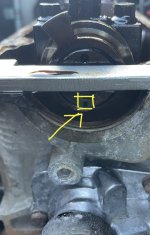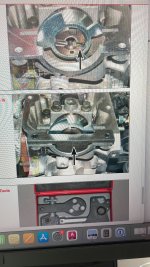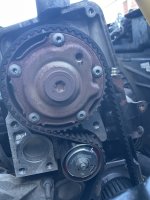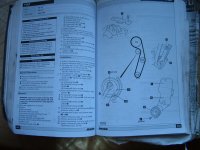Hi Ralf S, I'm new to this, but interpreted as fit all the locking tools, belt and tensioner ( but not fully tensioned) remove locking tools, turn over twice to make sure nothing misaligned inside, then fully tension the belt.
I read somewhere on here that when you originally go to put the Belt on it will be half a tooth out at cam and you need to move it clockwise 1/2 tooth, as when you fully tension the belt it will pull it back anticlockwise 1/2 a tooth and the you will be perfectly in time, apparently a lot of people turn the cam anticlockwise to get the belt to fit originally and then when tightened end up a tooth out.
God I pray I got that right as fitting my first one at the weekend.

Ok, first off, I'm talking FIRE 8 valve engines here because it's what I know best. The very early engines had timing marks on the pulleys lining up for timing and doing a belt was a doddle! However on the later engines (my 2010 is one) there is no timing mark on the cam pulley. So you need the locking kit. The crank and cam locking tools are designed to be used in exactly the way the FIAT workshop manual describes the task be done. fit the crank locking tool (which can be 180 degrees out of course - so careful) and check the cam locking tool drops into it's slot. - if not turn the crankshaft another complete turn - which takes the cam on by half a turn of course. with cam and crank locked up you can now slacken the adjuster and remove the old belt. Fiat now want you to slacken the cam pulley main bolt which will allow the cam pulley to spin freely on the camshaft. It doesn't need to be slackened much, half a turn is plenty, but there are some problems with doing this. The first, and not inconsiderable one is that the bolt is VERY tight - it has to be to lock the pulley to the camshaft itself. But you MUST NOT have the cam locking tool engaged with the slot in the end of the cam when doing this as it's easy to break lumps off the end of the cam! By the way, if your cam pulley is a solid cast one then the bolt you see when looking at it is the actual bolt. However if you're working on a VVT engine (see the third picture in the OP's first post here) then the bolt head is actually under the Torx bolt you see in that picture. In the VVT pulley that "bolt" is just a plug holding in the oil for the VVT - so get a rag ready to catch the oil if/when you remove it. Having established which type of pulley you have and got ready to undo the holding bolt you must remove the locking tool and hold the camshaft itself with a spanner (open ended) or other suitable tool so you can resist the tendency for it to rotate as you attempt to slacken the big bolt on the pulley. Now refit the cam locking tool to synch up the timing again. With the tools back in place you have a cam and crankshaft correctly timed to each other but with a free running cam pulley. Fit your new tensioner and water pump (I always do a water pump) and then install the new belt. I go round the crank pulley first and wedge it against the toothed pulley with a wee bit of wood or anything to hand. Then up over the water pump, around the top pulley wriggling it into place past the tensioner pulley and, making sure the teeth are all in mesh, apply tension with the tensioner pulley. You'll notice as you do this that the cam pulley rotates slightly anti-clockwise as the tension is taken up. All good so far? Well yes, but now you've got to tighten the cam pulley bold without doing any damage to the cam locking tool! So you can tighten it to a moderate extent with little risk to the locking tool but you must remove the cam locking tool when you finally tighten it to the recommended torque. The problem now becomes how to stop the camshaft moving relative to the pulley as you "lean" hard on the big bolt. Part of the locking tool kit should be a wee blocking tool which locks the pulley to the head but you've got to stop the cam itself moving relative to the pulley and so the big spanner on the cam itself comes into play again. It aint easy". When you've finished, Of course, if nothing has moved, the cam locking tool should still drop into the slot on the back end of the cam, if it doesn't then you've got to slacken it and start again. If it does all line up then the crank, slowly and with the plugs out so there's no compression, to check if the valves are touching.
Well, I'm a great believer in letting sleeping dogs lie. So, I thought, many years ago, if the cam pulley has been locked up in the correct position by the last person who did a belt on the engine, why would you need to "mess" with the cam pulley at all? I researched cam belt design and wrote to the manufacturers where I found that manufacturing tolerances on these products are very tight indeed - so, as long as you use a "big name" kit, one manufacturer's belt is going to be, as near as makes no odds, dimensionally identical to another. Now, this simplifies things considerably I thought.
So, I do these without slackening the cam pulley bolt. I first, before removing the old belt, check that both cam and crank locking tools fit. If they do, happy days. If they don't then the pulley is incorrectly fitted and the bolt will have to be slackened to allow realignment using the locking tools in the way that FIAT specify. I've done a number of these on both 1.2 and 1.4 8 valve Fire engines from Panda and Punto models and, so far, haven't found one miss-timed. So, with both locking tools fitted, slacken the tensioner and remove the old belt. Change the water pump if you're going to, and remove the old tensioner. Fit the new tensioner and offer the new belt up starting at the crank, round the water pump and then the cam pulley. Pull the belt nice and tight just by hand but you'll find the belt is about half a tooth out of going into mesh with the cam pulley! This is because the pulleys are locked in the running position with the cam pulley in the correct running position FOR A FULLY TIGHTENED BELT! You'll never get it on. So most settle for lining it up with the next tooth which puts you one tooth retarded once the tensioner is tightened. So what you need to do is remove the cam locking tool and turn the cam pulley just slightly clockwise until the belt can be made to mesh. Now tighten the tensioner and you'll find the cam locking tool will once again be lining up with it's slot. I've never had a problem doing it this way and, what's more it's the way the wee garages around here all do it. Also, not one of the one's I've done this way needed a Phonic Wheel Relearn on completion but there are reports that if you disturb the cam pulley bolt, they nearly always need a relearn.
Now I must say that the above is not intended as a complete DIY set of instructions as to how to fit these belts. I'm sure it'll all make a lot of sense to an experienced mechanic or enthusiast but, on the VVT engines in particular - which are "interference" engines - the results of getting this wrong can be catastrophically expensive (maybe new engine needed) So, unless you really know what you're doing you're best to leave this to "the professionals" and, reading some of the threads and posts regarding this job, even the experienced sometimes end up with a "sick" running engine due to getting it wrong - very often with the belt one tooth out.





